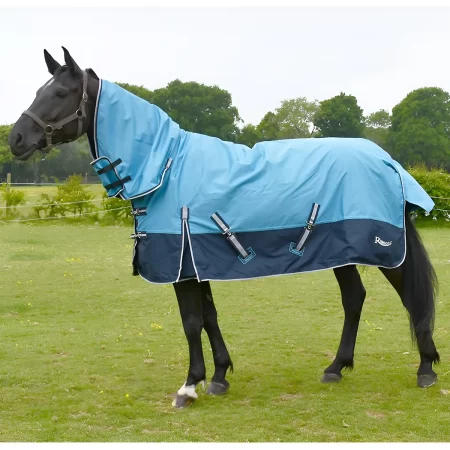Forage feed (grass or hay) provides a horse with the fibre necessary to keep the horse's digestive system functioning properly and a horse should have access to forage feed through much of the day and night. Forage feed should make up at least half, preferably all, of a horse's daily intake of food. As forage feed is such an important factor of a horse's diet the highest quality forage feed available should be provided.
Grass
Any pasture on which horses graze should be well managed and free from poisonous plants.
Grass clippings should not be fed as they can cause digestive disturbances, serious gas or impaction colic.
Hay
Hay is dried grass and any hay fed should be green and free from dust and mould as dusty hay can cause respiratory problems and mouldy hay may cause colic. Bales of hay can be checked for colour - although the exterior may be bleached by the sun, check the inside of the bale for colour. Bales can be checked for mould by placing a hand into the centre of the bale to ensure it is not warm, checking for areas of dark discolouration and by smell (hay should smell like freshly mown grass).
Slices of hay can be shook apart before feeding to shake out dust. Alternatively hay can be soaked to remove dust, although soaking hay also reduces its nutritional value. Steaming hay kills fungal spores, dust mites and bacteria without the loss of nutritional value that occurs during soaking.
If hay is to be stored outside it should be kept dry by keeping it off the ground and thoroughly covered in waterproof material.
Types of hay
Seed hay
Seed hay is taken from pasture grown especially for hay making from grass seed, has a higher nutritional value than meadow hay, and is lighter in colour.
Meadow hay
Meadow hay is taken from permanent pasture and may contain a wider variety of grasses than seed hay as well as clover, herbs and wild flowers. Meadow hay is more easily digested than seed hay.
Alfalfa hay
Alfalfa hay, also known as Lucerne hay, is palatable and a good source of nutrients, typically higher in protein and calcium, and higher in energy than other hays although the density of nutrients varies with the time of harvest.
Alfalfa hay cut at early maturity is very palatable, leafy and high in nutrients and is suitable for horses with high nutrient requirements such as growing horses, horses with poor appetites, horses in moderate to heavy work, horses in poor condition and lactating mares. It should be fed carefully and in rations to horses with low nutrient requirements to prevent over-eating, excitability and obesity.
Alfalfa hay cut at late maturity has more stem and less leaf and has a lower nutrient value and can be used for horses at rest, in light work or in the early stages of pregnancy.
Haylage
Haylage is taken from early cut semi-wilted grass and is a lot richer than hay so should be fed more sparingly. It is compressed and wrapped in a thick plastic wrapper that is heat sealed to retain the moisture. Mild fermentation occurs that prevents fungal spores developing. Haylage should be used within 2-4 days (summer-winter) once the wrapper is opened.




















